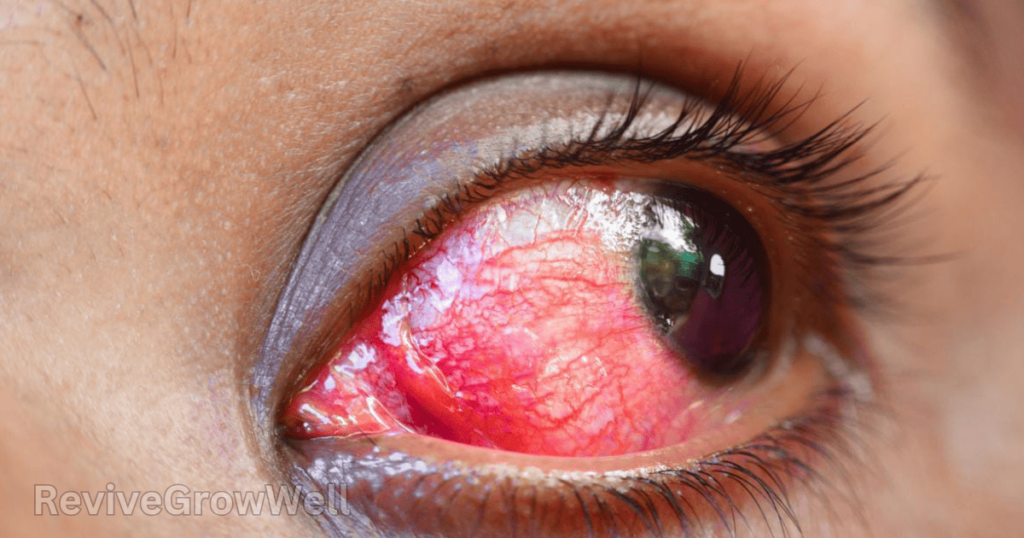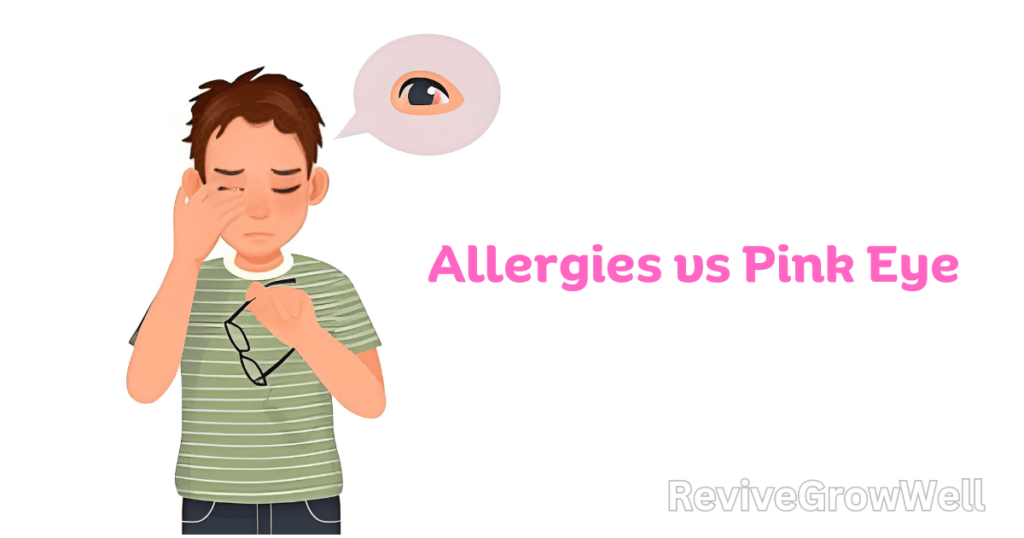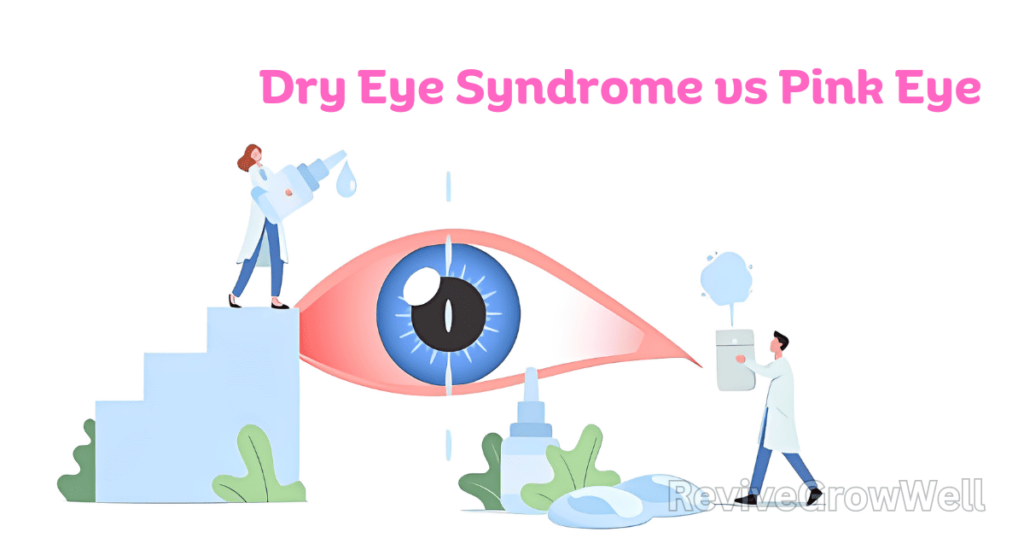Pink eye, or conjunctivitis as it’s formally known, is a common eye issue that many of us have to deal with at some point in our lives. It’s basically when the clear, thin layer covering the white part of your eye and the inside of your eyelid, called the conjunctiva, gets all inflamed.
Now, pink eye can show up for various reasons like viruses, bacteria, allergies, or even things that irritate your eyes. But here’s the tricky part: it often gets confused with other eye problems and irritations, leading to misdiagnoses.
So, in this article, we’ll dive into what often gets mistaken for pink eye and learn how to tell the difference between them. Our focus is on ‘What is Commonly Misdiagnosed as Pink Eye?’ because we want to clear up the confusion and help you understand when it’s really pink eye and when it’s something else entirely.
Understanding Pink Eye (Conjunctivitis)
Before we delve into misdiagnoses, it’s essential to understand what pink eye is. There are three primary types of pink eye: viral, bacterial, and allergic. Each class has distinct causes, symptoms, and treatments, making accurate diagnosis crucial.
A virus, such as the common cold, typically causes viral conjunctivitis. It is highly contagious and often results in redness, watery eyes, and itching. Bacterial conjunctivitis, on the other hand, is caused by bacteria and leads to symptoms like thick yellow discharge and eyelid crusting. Allergic conjunctivitis is triggered by allergens, leading to itchy, watery eyes and sometimes nasal symptoms.
Common Symptoms of Pink Eye
Pink eye shares some common symptoms, regardless of its underlying cause. These symptoms include redness in the white of the eye, increased tearing, itching or burning sensation, and sensitivity to light.
However, the specific symptoms and their severity can vary depending on the type of pink eye.
What is Commonly Misdiagnosed as Pink Eye?

1. Allergies
Have you ever wondered what might be easily confused with pink eye? Well, allergies are a frequent culprit for this confusion. They can cause eye irritation and redness, which often leads to a misdiagnosis of pink eye.
Allergies set off a chain reaction in your body, releasing histamines that result in symptoms such as itchy eyes and too many tears. So, it’s not uncommon for allergies to be mistaken as the pink eye!
2. Dry Eye Syndrome
Do you ever wonder about conditions often mistaken for pink eye? One common condition is Dry Eye Syndrome. It occurs when your eyes don’t produce enough tears or the quality of tears is poor.
This can result in a range of discomforts, including redness, and that gritty feeling in your eyes. These symptoms can easily be confused with Pink Eye, but it’s essential to know the difference.
3. Eye Infections
You know, sometimes, eye infections can make you think you have pink eye, but it’s not always the case. There are a few other eye problems that can look a lot like pink eye. These include things like keratitis, blepharitis, uveitis, and corneal ulcers.
These tricky conditions can give you red eyes, make your eyes hurt, and even cause some stuff to come out of your eyes. It’s important to know about these look-alikes so you can get the right help when you need it!
4. Foreign Body Sensation
Have you ever felt like there’s something in your eye, and you thought it might be Pink Eye? Well, you’re not alone! This sensation is known as a ‘Foreign Body Sensation.’ It happens when tiny things like dust or an eyelash get stuck in your eye.
Imagine walking outside on a windy day, and a speck of dust or a tiny eyelash blows into your eye. That’s when you might start feeling like you have Pink Eye. But don’t worry, it’s not an eye infection like Pink Eye, just a little foreign object causing discomfort. It’s important to know the difference so you can take the right steps to make your eye feel better.
5. Bacterial and Viral Conjunctivitis
Now, let’s talk about two sneaky eye conditions called bacterial and viral conjunctivitis. Sometimes, they like to play tricks on us because they can seem really similar. They can both make your eyes red, gooey, and not feel very nice.
Imagine you’ve got a detective hat on, and you need to tell them apart. Bacterial conjunctivitis is caused by naughty bacteria, while viral conjunctivitis is caused by tricky viruses. Even though they look alike, doctors have some clever ways to figure out who’s who. Understanding the difference can help you get the right treatment and feel better faster.
The Importance of Accurate Diagnosis
Getting the right diagnosis is super important because it helps us choose the right treatments. Imagine if we thought you had one problem, but it was actually something else – that could lead to treatments that don’t work and make you feel uncomfortable for no reason. So, it’s crucial to tell Pink Eye apart from other things that might seem similar.
Allergies vs. Pink Eye: Spotting the Differences

Itchy Eyes
You know that feeling when your eyes start itching, and you can’t resist rubbing them? Well, it’s essential to understand that itching can tell us a lot about our eye health.
Allergies and pink eye are two things that can make your eyes feel pretty uncomfortable. The big difference is itching. With allergies, itching is almost always there. It’s like an unwelcome guest that won’t leave! On the other hand, the pink eye might or might not come with itching.
So, here’s the deal: If your eyes are itching like crazy, it’s probably allergies causing the trouble. But if there’s no itching, it might be something else, like pink eye. It’s like a secret code your eyes are trying to tell you, and by understanding it, you can help your eyes feel better and stay healthy!
Discharge
Let’s talk about something important: discharge from your eyes. When you have pink eye, commonly misdiagnosed as pink eye, it usually comes with a clear or white discharge, like tears. But when allergies are at play, you’ll likely see watery discharge, almost like waterworks!
Now, here’s the crucial part: if that discharge is thick, yellow, or green, it’s a sign that something else might be going on. It’s more likely to be a bacterial infection, which is different from pink eye. So, if you see these colorful and gooey eye surprises, it’s essential to let a doctor know. It’s like your eyes are sending you a message, saying, ‘Hey, something’s not quite right in here!
Seasonal Patterns
Allergies often follow seasonal patterns, with symptoms flaring up during specific times of the year when allergens are prevalent. Pink eye, on the other hand, can occur at any time, regardless of the season.
Response to Allergy Medication
A reliable way to distinguish between allergies and pink eye is by assessing the response to allergy medication. If symptoms improve with antihistamines or allergy eye drops, it’s more likely allergies. Accurate diagnosis and appropriate treatment are crucial for managing these conditions effectively.
Dry Eye Syndrome vs. Pink Eye: Key Distinctions

Tear Production
In dry eye syndrome, the primary issue is inadequate tear production. Pink eye, however, results in excess tearing.
Eye Fatigue
Have you ever experienced that tired, strained feeling in your eyes after a long day? It might be more than just tiredness. Dry eye syndrome can often be the culprit behind this eye fatigue. Unlike pink eye, known for redness and irritation, dry eye syndrome manifests differently.
When your eyes don’t produce enough tears or the quality of those tears is poor, it can lead to eye fatigue. This condition is marked by discomfort, grittiness, and a persistent sense of tiredness in your eyes.
Understanding the distinction between dry eye syndrome and pink eye is crucial for your eye health. So, next time your eyes feel tired, remember it might be more than just fatigue – it could be dry eye syndrome.
Environmental Factors
Let’s talk about how our surroundings can impact our eye health. Dry or windy environments can make dry eye syndrome even more uncomfortable. On the other hand, pink eye is something you want to avoid, as it’s highly contagious and can easily spread from one person to another. Understanding these factors can help you protect your eyes and those around you..
Eye Infections Misdiagnosed as Pink Eye
Keratitis
Imagine this: you wake up with red, uncomfortable eyes and immediately assume it’s Pink Eye. But hold on! It could be something entirely different and equally troublesome—keratitis, which is commonly misdiagnosed as Pink Eye.
Keratitis is a condition where the cornea, the clear front surface of your eye, becomes inflamed. This inflammation can lead to intense eye pain, heightened sensitivity to light, and even decreased vision. Here’s the kicker: keratitis often gets mistaken for Pink Eye because of the telltale redness and discomfort it brings.
So, why should you care about distinguishing between the two? Knowing the difference can make a difference in getting the proper treatment and preventing further complications. Don’t let your eyes suffer needlessly; give yourself the knowledge to keep them healthy and happy.
Blepharitis
Blepharitis is when the edges of your eyelids become inflamed, resulting in redness and swelling, which is commonly misdiagnosed as pink eye due to their similar appearances. Sometimes, it’s mistaken for pink eye due to their similar appearances. However, it’s crucial to differentiate the two.
Imagine this scenario: you wake up with red, swollen eyelids and immediately think it’s pink eye. But it might be blepharitis instead, a condition that is often confused with pink eye. What’s the difference, you ask? Let’s dive into it so you can confidently tell them apart.
Blepharitis isn’t contagious like pink eye and is not an infection. Instead, it’s often caused by clogged oil glands along the eyelid margins. When these glands become blocked, it triggers irritation and inflammation, leading to those telltale red, swollen eyelids.
So, how can you spot the difference? While pink eye tends to have a watery discharge, blepharitis typically results in a thicker, yellowish crust along the eyelids. Your eyes may feel gritty and uncomfortable in both cases, but knowing these distinctions can help you decide on the next treatment steps.
Uveitis
Imagine experiencing redness, pain, and vision problems in your eyes. These symptoms are not just frustrating; they can also be quite confusing. What if I told you that these discomforts could result from Uveitis?
Uveitis is an eye disease that affects the middle part of the eye and often goes unnoticed. The reason? Its symptoms can easily overlap with those of Pink Eye, a common eye issue. So, let’s break it down for you.
Uveitis might be masquerading as Pink Eye when your eyes become red painful, and your vision gets blurry. You may think it’s just a case of Pink Eye, but it could be more. Understanding this is crucial because the treatment and management for Uveitis differ from what you’d do for Pink Eye.
Uveitis and Pink Eye can look quite similar, but they are entirely different conditions requiring distinct approaches. So, the next time you experience eye redness, pain, or vision problems, don’t just assume it’s Pink Eye. Consider whether you have Uveitis and see a doctor to get the right diagnosis and treatment. Your vision and eye health are worth it.
Corneal Ulcers
Let’s talk about corneal ulcers, which are tiny open sores on the clear front surface of your eye called the cornea. They can be pretty painful and might make your eye discharge fluid. Interestingly, they often get mixed up with another eye condition called bacterial conjunctivitis, which also involves gooey eye discharge.
Now, why should you care about this? Corneal ulcers, though small, can lead to big problems if left untreated. They can affect your vision and cause a lot of discomfort. So, it’s crucial to know the difference and seek proper care if you suspect you might have one. Your eye health is nothing to take lightly!
Foreign Body Sensation: When It's Not Pink Eye
A foreign body sensation in the eye can occur when debris or a small object gets trapped. This feeling is often mistaken for pink eye but can be relieved by removing the irritant.
Before we delve into misdiagnoses, it’s essential to understand what pink eye is. There are three primary types of pink eye: viral, bacterial, and allergic. Each class has distinct causes, symptoms, and treatments, making accurate diagnosis crucial.
A virus, such as the common cold, typically causes viral conjunctivitis. It is highly contagious and often results in redness, watery eyes, and itching. Bacterial conjunctivitis, on the other hand, is caused by bacteria and leads to symptoms like thick yellow discharge and eyelid crusting. Allergic conjunctivitis is triggered by allergens, leading to itchy, watery eyes and sometimes nasal symptoms.
Bacterial and Viral Conjunctivitis: How to Tell Them Apart
Bacterial conjunctivitis typically involves thicker discharge and may lead to crusty eyelashes. Viral conjunctivitis often causes a more watery discharge and may accompany cold or respiratory symptoms.
Treatment for Pink Eye
The treatment of pink eye varies based on its cause. Viral conjunctivitis often resolves on its own, while bacterial conjunctivitis may require antibiotics. Allergic conjunctivitis can be managed with antihistamines and avoiding allergens. Dry eye syndrome may necessitate artificial tears or other medications.
Eye Care Tips
The treatment of pink eye varies based on its cause. Viral conjunctivitis often resolves on its own, while bacterial conjunctivitis may require antibiotics. Allergic conjunctivitis can be managed with antihistamines and avoiding allergens. Dry eye syndrome may necessitate artificial tears or other medications.
Conclusion
In conclusion, understanding what is commonly misdiagnosed as pink eye is crucial because pink eye is a common eye condition, but it is frequently misdiagnosed due to its resemblance to other eye issues.
Accurate diagnosis is crucial to ensure the right treatment is administered. Understanding the differences between pink eye, allergies, dry eye syndrome, eye infections, and foreign body sensations can help individuals and healthcare providers make informed decisions about their eye health.
Frequently Asked Questions
Can I use over-the-counter eye drops for pink eye?
Over-the-counter eye drops can help relieve some symptoms of pink eye, but it’s essential to consult with a healthcare provider for a proper diagnosis and treatment plan.
Are all cases of red, itchy eyes pink eye?
Not necessarily. Red, itchy eyes can be a symptom of various eye conditions, including allergies, dry eye syndrome, and eye infections.
Is pink eye contagious?
Yes, some forms of pink eye, such as viral and bacterial conjunctivitis, are contagious. To stop it from spreading, it’s important to be careful.
How can I differentiate between viral and bacterial conjunctivitis?
The discharge in viral conjunctivitis is typically watery, while bacterial conjunctivitis produces a thicker, yellow or green discharge.
What are the distinguishing factors between viral and bacterial conjunctivitis?
If you experience severe eye pain, vision problems, or persistent symptoms, it’s important to consult with an eye specialist or healthcare provider for a proper evaluation.























1 thought on “What is Commonly Misdiagnosed as Pink Eye? Revealed!”
Can I just say what a relief to find someone who actually knows what theyre talking about on the internet. You definitely know how to bring an issue to light and make it important. More people need to read this and understand this side of the story. I cant believe youre not more popular because you definitely have the gift.